A Sub-6 GHz 8 × 8 MIMO Antenna Array for 5G Metal-Frame Mobile Phone Applications
Abstract
:1. Introduction
2. Antenna Design and Simulated Results
2.1. Antenna Structure and Principle
2.2. Antenna Design Process
2.2.1. Analyses of the Single Antenna
2.2.2. Isolation Analysis
2.3. Surface Current and Electric Field Distributions
3. Parametric Studies
4. Results and Discussion
5. Conclusions
Author Contributions
Funding
Data Availability Statement
Acknowledgments
Conflicts of Interest
References
- Huang, D.; Du, Z.; Wang, Y. A Quad-Antenna System for 4G/5G/GPS Metal Frame Mobile Phones. IEEE Antennas Wirel. Propag. Lett. 2019, 18, 1586–1590. [Google Scholar] [CrossRef]
- Choi, J.; Hwang, W.; You, C.; Jung, B.; Hong, W. Four-Element Reconfigurable Coupled Loop MIMO Antenna Featuring LTE Full-Band Operation for Metallic-Rimmed Smartphone. IEEE Trans. Antennas Propag. 2019, 67, 99–107. [Google Scholar] [CrossRef]
- Liu, Y.; Cui, W.; Jia, Y.; Ren, A. Hepta-Band Metal-Frame Antenna for LTE/WWAN Full-Screen Smartphone. IEEE Antennas Wirel. Propag. Lett. 2020, 19, 1241–1245. [Google Scholar] [CrossRef]
- Liu, Y.; Zhou, Y.-M.; Liu, G.-F.; Gong, S.-X. Heptaband Inverted-F Antenna for Metal-Rimmed Mobile Phone Applications. IEEE Antennas Wirel. Propag. Lett. 2016, 15, 996–999. [Google Scholar] [CrossRef]
- Qiu, P.; Feng, Q. Low-Profile Compact Antenna for Octa-Band Metal-Rimmed Mobile Phone Applications. IEEE Trans. Antennas Propag. 2020, 68, 54–61. [Google Scholar] [CrossRef]
- Chang, L.; Yu, Y.; Wei, K.; Wang, H. Polarization-Orthogonal Co-frequency Dual Antenna Pair Suitable for 5G MIMO Smartphone with Metallic Bezels. IEEE Trans. Antennas Propag. 2019, 67, 5212–5220. [Google Scholar] [CrossRef]
- Sun, L.; Li, Y.; Zhang, Z. Wideband Decoupling of Integrated Slot Antenna Pairs for 5G Smartphones. IEEE Trans. Antennas Propag. 2021, 69, 2386–2391. [Google Scholar] [CrossRef]
- Chen, S.-C.; Chou, L.-C.; Hsu, C.-I.G.; Li, S.-M. Compact Sub-6-GHz Four-Element MIMO Slot Antenna System for 5G Tablet Devices. IEEE Access 2020, 8, 154652–154662. [Google Scholar] [CrossRef]
- Chen, Q.; Lin, H.; Wang, J.; Ge, L.; Li, Y.; Pei, T. Single Ring Slot-Based Antennas for Metal-Rimmed 4G/5G Smartphones. IEEE Trans. Antennas Propag. 2019, 67, 1476–1487. [Google Scholar] [CrossRef]
- Yuan, X.-T.; He, W.; Hong, K.-D.; Han, C.-Z.; Chen, Z.; Yuan, T. Ultra-Wideband MIMO Antenna System with High Element-Isolation for 5G Smartphone Application. IEEE Access 2020, 8, 56281–56289. [Google Scholar] [CrossRef]
- Cai, Q.; Li, Y.; Zhang, X.; Shen, W. Wideband MIMO Antenna Array Covering 3.3–7.1 GHz for 5G Metal-Rimmed Smartphone Applications. IEEE Access 2019, 7, 142070–142084. [Google Scholar] [CrossRef]
- Chen, H.-D.; Tsai, Y.-C.; Sim, C.-Y.-D.; Kuo, C. Broadband Eight-Antenna Array Design for Sub-6 GHz 5G NR Bands Metal-Frame Smartphone Applications. IEEE Antennas Wirel. Propag. Lett. 2020, 19, 1078–1082. [Google Scholar] [CrossRef]
- Alja’afreh, S.S.; Altarawneh, B.; Alshamaileh, M.H.; E’qab, R.A.; Hussain, R.; Sharawi, M.S.; Xing, L.; Xu, Q. Ten Antenna Array Using a Small Footprint Capacitive-Coupled-Shorted Loop Antenna for 3.5 GHz 5G Smartphone Applications. IEEE Access 2021, 9, 33796–33810. [Google Scholar] [CrossRef]
- Li, Y.; Sim, C.-Y.-D.; Luo, Y.; Yang, G. Multiband 10-Antenna Array for Sub-6 GHz MIMO Applications in 5-G Smartphones. IEEE Access 2018, 6, 28041–28053. [Google Scholar] [CrossRef]
- Lun, Y.; Zhang, G.; Li, Z.; Suo, J.; Yue, J.; Che, Z. A Compact 5G Dual-Band MIMO Antenna with Pattern Diversity for Mobile Phone. In Proceedings of the 2020 Cross Strait Radio Science & Wireless Technology Conference (CSRSWTC), Fuzhou, China, 13–16 December 2020. [Google Scholar]
- Yang, K. Research and Design of a High Isolation 5G Antenna for Smart Phone. In Proceedings of the 2020 3rd International Conference on Information and Computer Technologies (ICICT), San Jose, CA, USA, 9–13 March 2020. [Google Scholar]
- Satyanarayana, B.; Srivastava, S.K.; Meshram, M.K. Eight-Element Dual-Band MIMO Antenna System for Sub-6 GHz 5G Smartphone Applications. In Proceedings of the 2019 IEEE Indian Conference on Antennas and Propagation (InCAP), Ahmedabad, India, 19–22 December 2019. [Google Scholar]
- Deng, C.; Lv, X. Eight-element MIMO Antenna with Tightly-arranged Pairs for 5G Mobile Terminal. In Proceedings of the 2019 IEEE International Symposium on Antennas and Propagation and USNC-URSI Radio Science Meeting, Atlanta, GA, USA, 12–14 July 2019. [Google Scholar]
- Jaglan, N.; Gupta, S.D.; Sharawi, M.S. 18 Element Massive MIMO/Diversity 5G Smartphones Antenna Design for Sub-6 GHz LTE Bands 42/43 Applications. IEEE Open J. Antennas Propag. 2021, 2, 533–545. [Google Scholar] [CrossRef]
- Wong, K.-L.; Chen, Y.-H.; Li, W.-Y. Decoupled compact ultra-wideband MIMO antennas covering 3300~6000 MHz for the fifth-generation mobile and 5GHz-WLAN operations in the future smartphone. Microw. Opt. Technol. Lett. 2018, 60, 2345–2351. [Google Scholar] [CrossRef]
- Serghiou, D.; Khalily, M.; Singh, V.; Araghi, A.; Tafazolli, R. Sub-6 GHz Dual-Band 8 × 8 MIMO Antenna for 5G Smartphones. IEEE Antennas Wirel. Propag. Lett. 2020, 19, 1546–1550. [Google Scholar] [CrossRef]
- TaiwanJaglan, N.; Gupta, S.D.; Kanaujia, B.K.; Sharawi, M.S. 10 Element Sub-6-GHz Multi-Band Double-T Based MIMO Antenna System for 5G Smartphones. IEEE Access 2021, 9, 118662–118672. [Google Scholar]
- Ahmad, U.; Ullah, S.; Rafique, U.; Choi, D.-Y.; Ullah, R.; Kamal, B.; Ahmad, A. MIMO Antenna System with Pattern Diversity for Sub-6 GHz Mobile Phone Applications. IEEE Access 2021, 9, 149240–149249. [Google Scholar] [CrossRef]
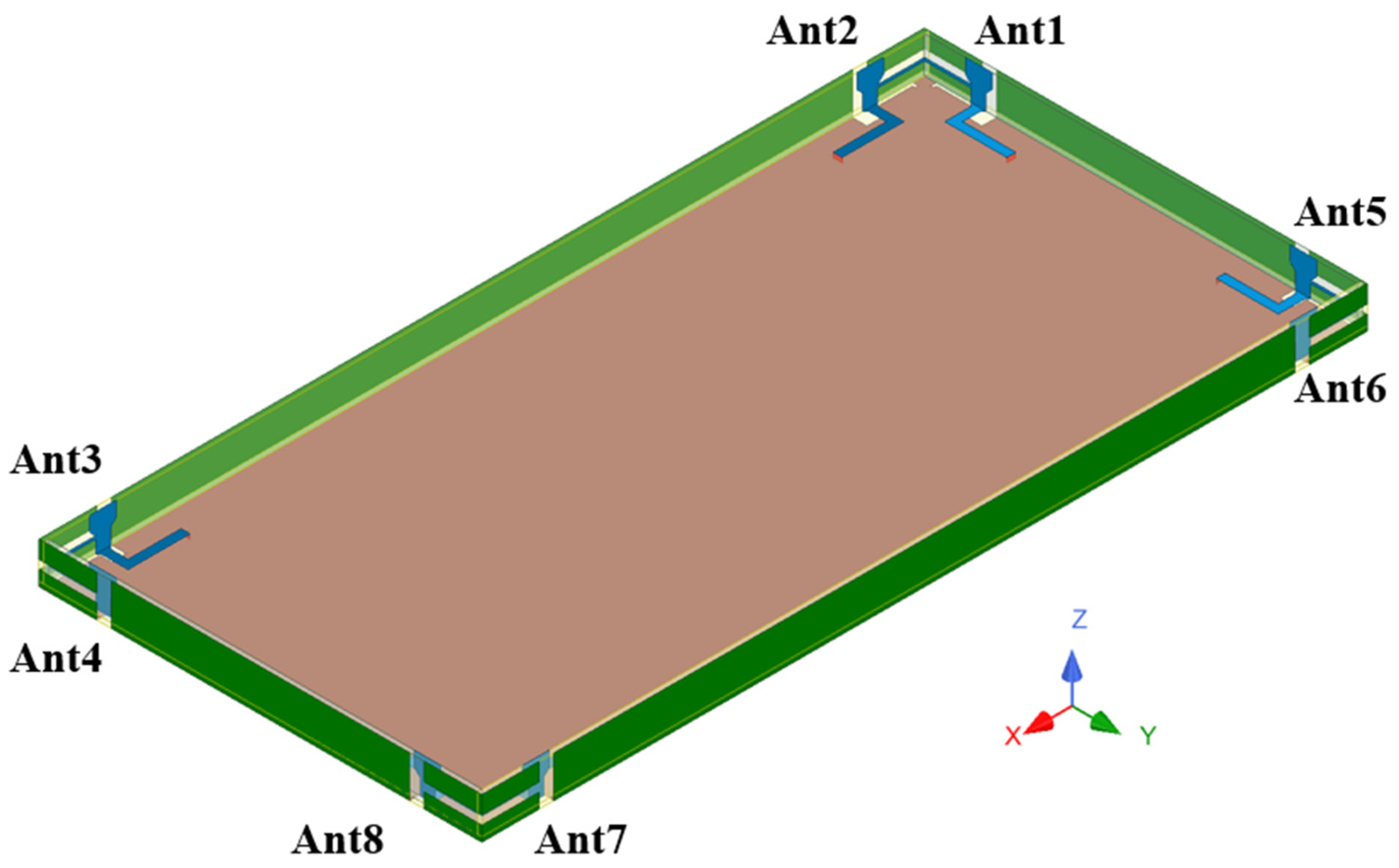

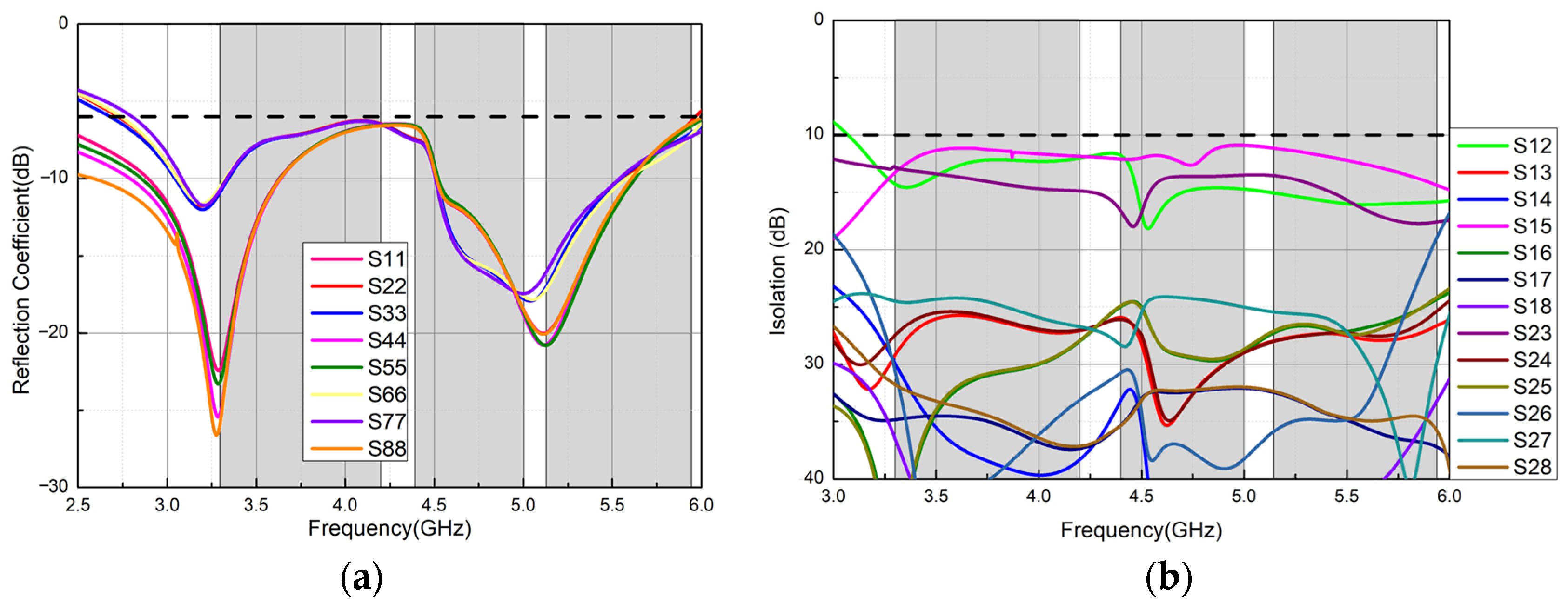
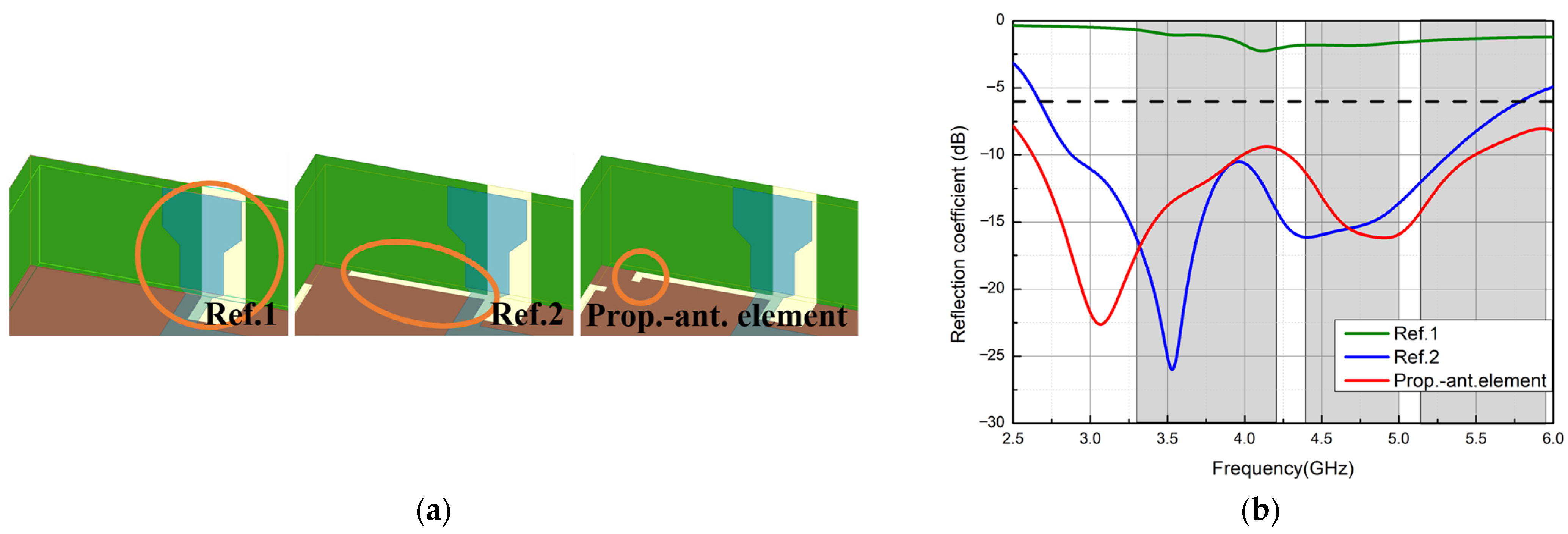
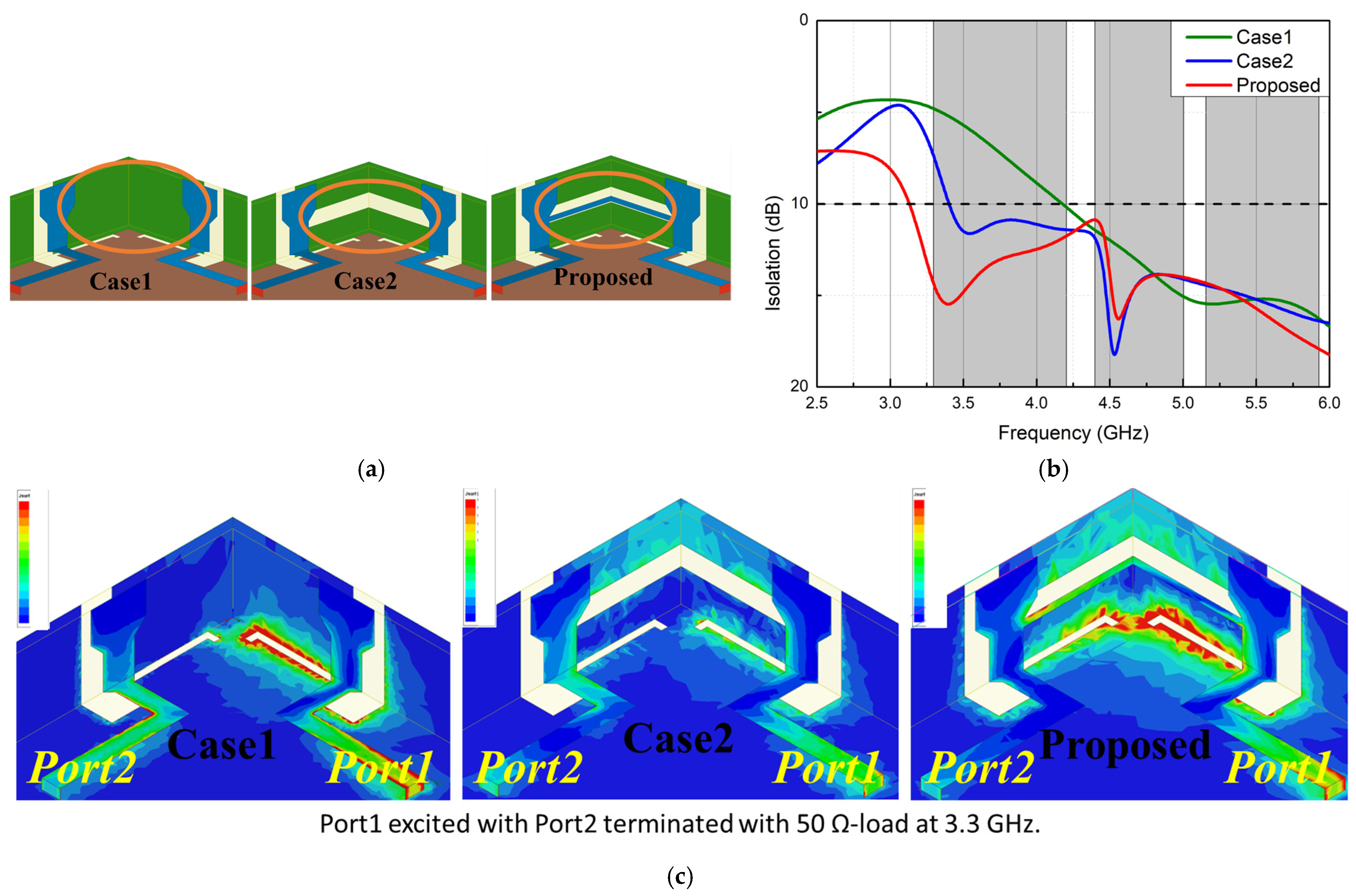

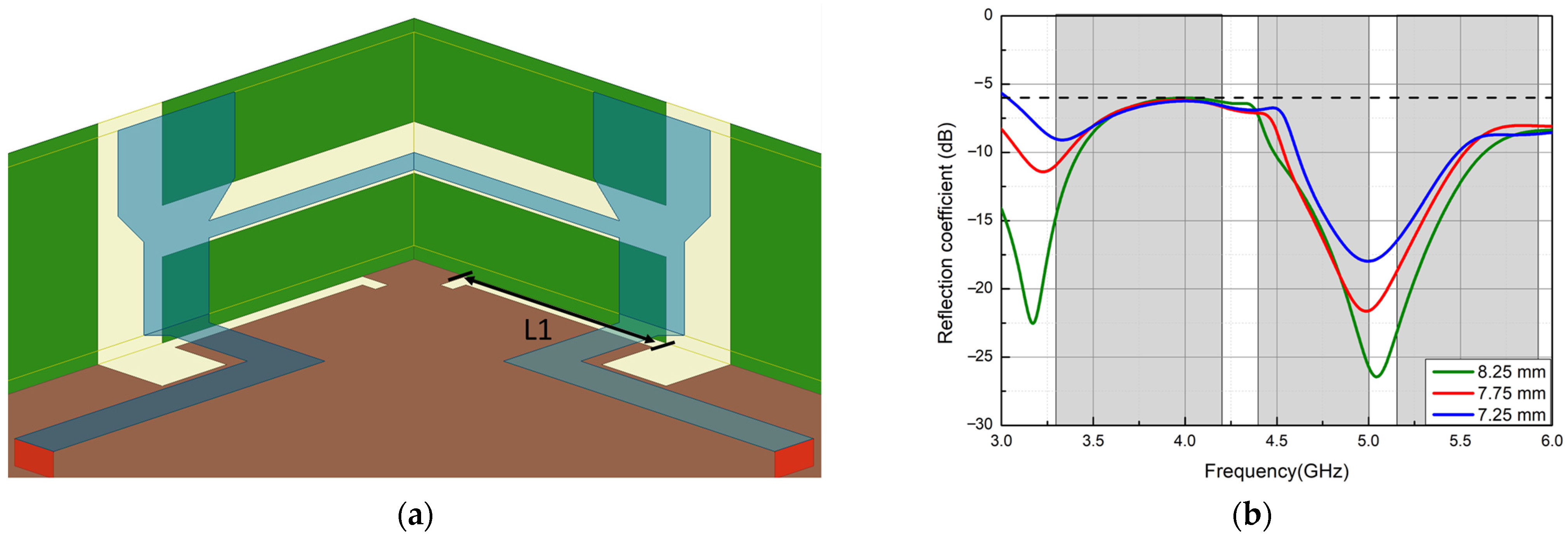
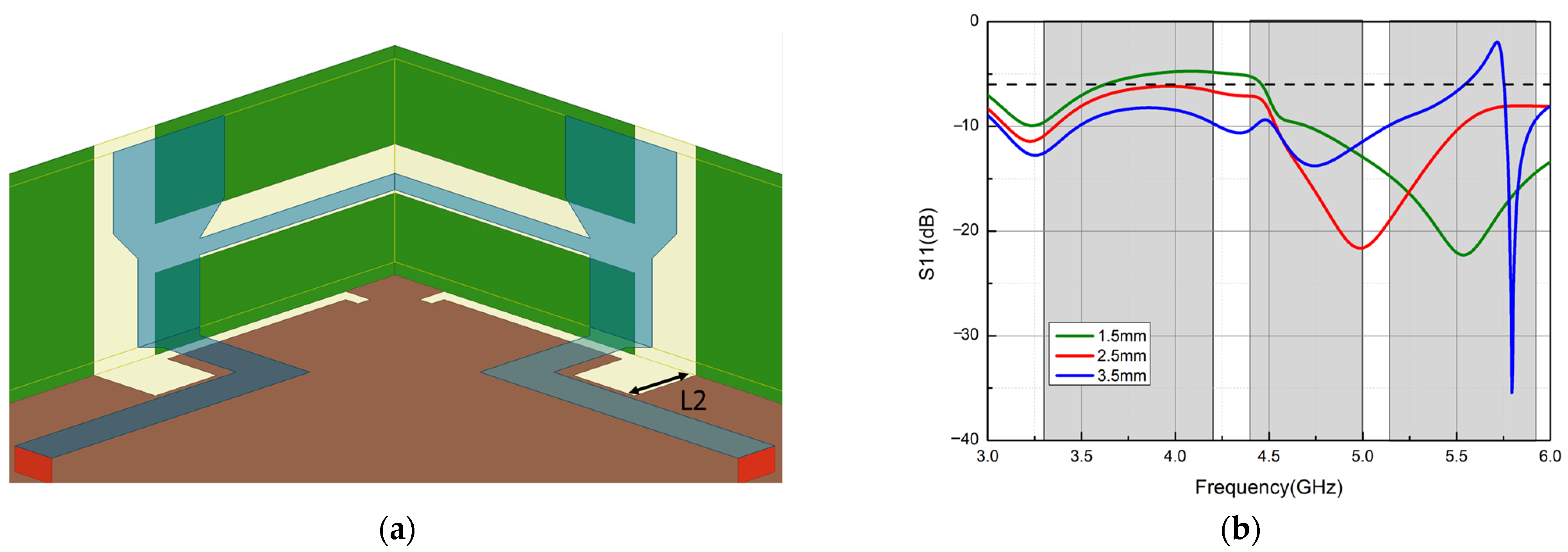
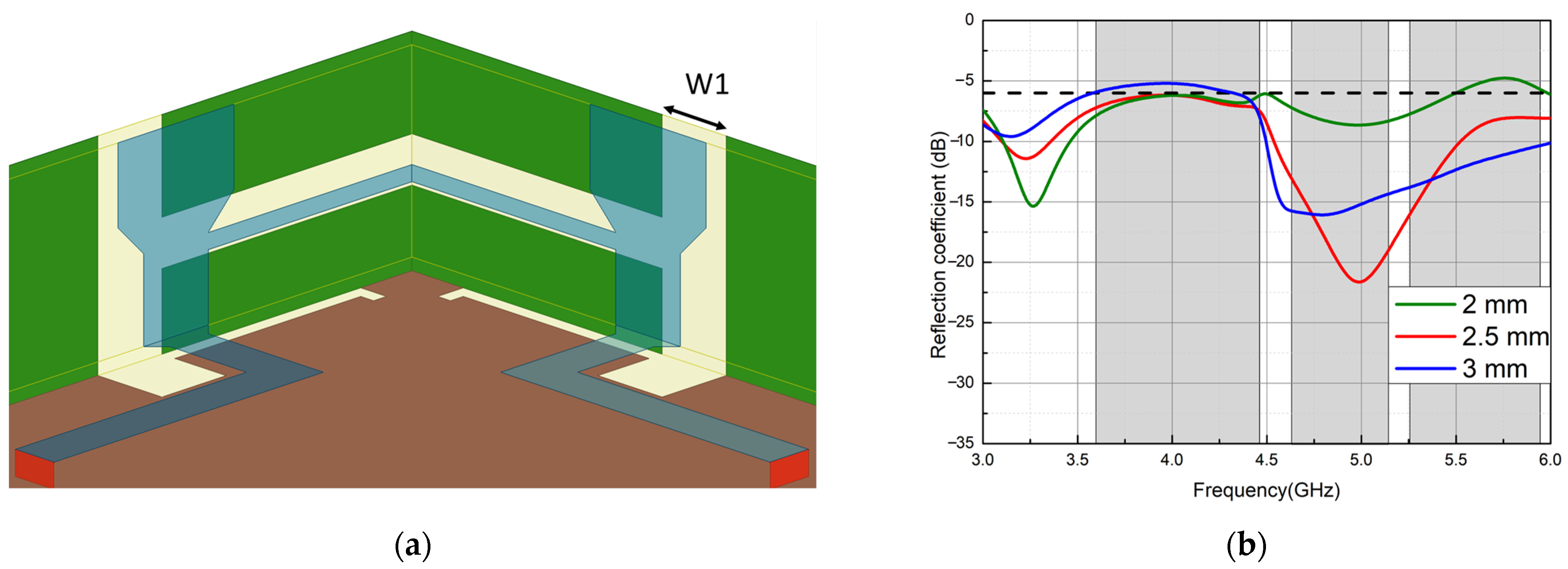








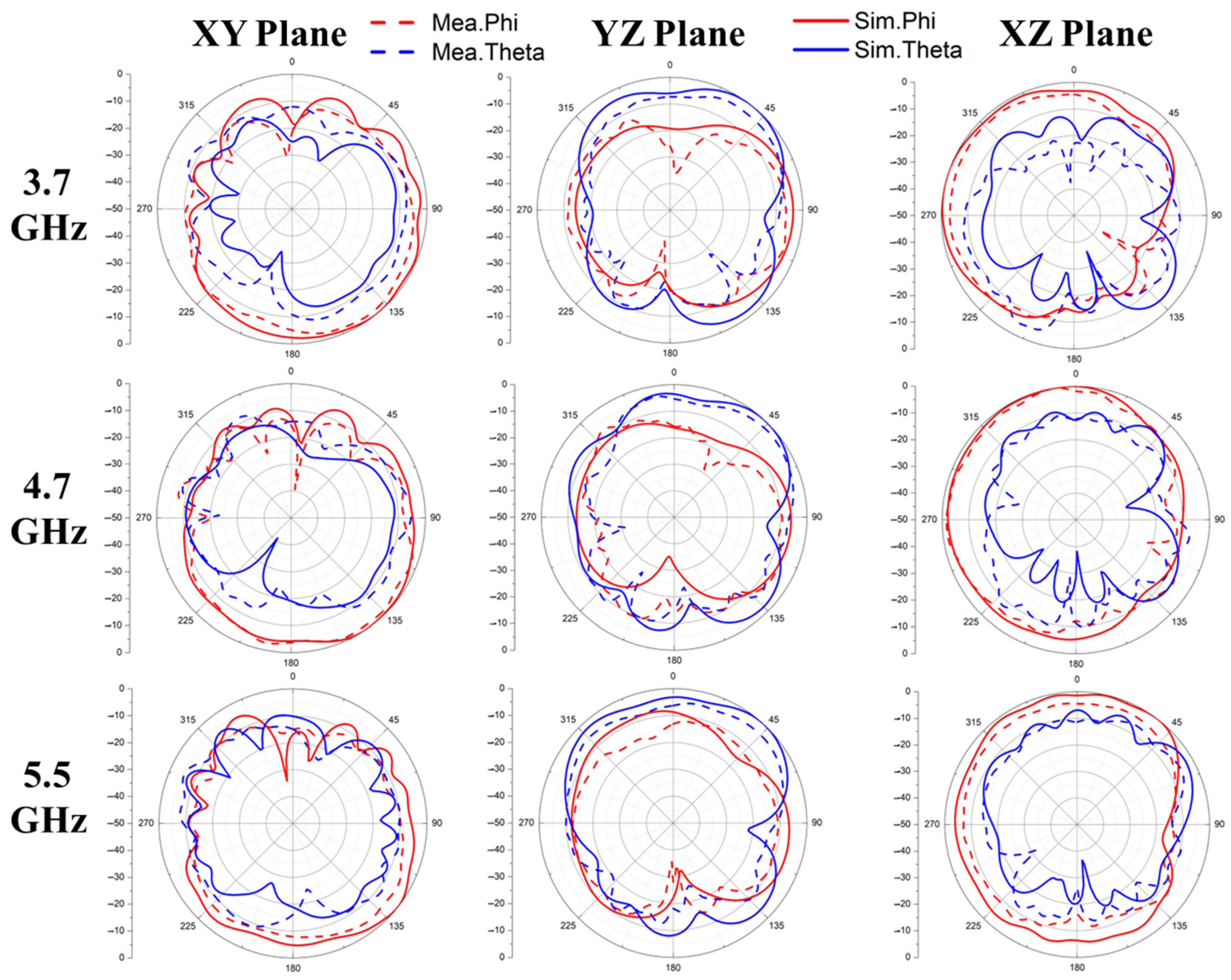

Disclaimer/Publisher’s Note: The statements, opinions and data contained in all publications are solely those of the individual author(s) and contributor(s) and not of MDPI and/or the editor(s). MDPI and/or the editor(s) disclaim responsibility for any injury to people or property resulting from any ideas, methods, instructions or products referred to in the content. |
© 2024 by the authors. Licensee MDPI, Basel, Switzerland. This article is an open access article distributed under the terms and conditions of the Creative Commons Attribution (CC BY) license (https://creativecommons.org/licenses/by/4.0/).
Share and Cite
Chen, Y.-T.; Su, H.-L. A Sub-6 GHz 8 × 8 MIMO Antenna Array for 5G Metal-Frame Mobile Phone Applications. Electronics 2024, 13, 4590. https://doi.org/10.3390/electronics13234590
Chen Y-T, Su H-L. A Sub-6 GHz 8 × 8 MIMO Antenna Array for 5G Metal-Frame Mobile Phone Applications. Electronics. 2024; 13(23):4590. https://doi.org/10.3390/electronics13234590
Chicago/Turabian StyleChen, Yu-Tung, and Hsin-Lung Su. 2024. "A Sub-6 GHz 8 × 8 MIMO Antenna Array for 5G Metal-Frame Mobile Phone Applications" Electronics 13, no. 23: 4590. https://doi.org/10.3390/electronics13234590
APA StyleChen, Y.-T., & Su, H.-L. (2024). A Sub-6 GHz 8 × 8 MIMO Antenna Array for 5G Metal-Frame Mobile Phone Applications. Electronics, 13(23), 4590. https://doi.org/10.3390/electronics13234590






